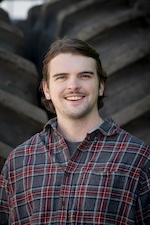Earlier I had a chance to stop inside the Iowa State University tent. And I talked with some of their researchers as well as ag tire expert James Tuschner. Let’s toss it over to them right now. We’re going to talk about PSI levels and compaction.
Mehari Tekeste: “So at the lab, what we start measuring is a footprint on an artificial soil, ag tires, a different higher inflation pressures, different load. So what we found is when you measure it on an artificial footprint, you're getting two advantages. One, we found out that the footprint is higher about 80% than a hard surface measurement, what everybody was doing.”
“The other thing is with the artificial soil, we are measuring 3D. It's a tire penetrated right depth, which you cannot measure on a hard surface. Why is it important is, doing it in our artificial soil, our artificial soil mimics about five typical Midwestern type soils in its penetration or sinkage measurement. It mimics very close to a field conditions.”
“And ag tires, when they are in the field, they deflect, tire deflect, soil deflect. That's the thing that we're doing at the lab with the artificial soil. The advantage of doing it with the artificial soil, it's a repeatable test. And we've been using it the same consistent behavior almost five years now. We measured in 2019, and we're measuring it every three years. It's mechanical behavior is consistently the same. And it's giving variability within less than 4% in the footprint measurement.”
James Tuschner: “So let me just get this straight. So first of all compare it to a flat plate. We've got about 80% difference in really the shear area because of the malleable surface. Right. And the physical properties of the tire. Correct. And the other piece of it too, with the artificial soil, is is that it's a repeatable format. So it's not like it's one soil Midwest, eastern, southeastern, whatever.”
“It's the same the exact touch every single time. And you can repeat the results and you always have a something that is consistent. Is that correct?”
Mehari Tekeste: “That's correct.”
Watch the full version of this episode of Conservation Ag Update.







